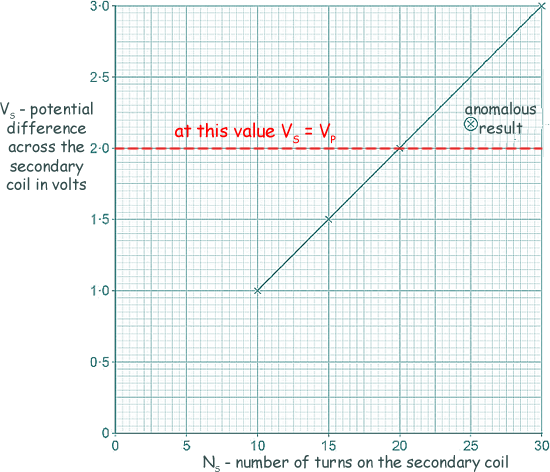GCSE Standard Questions: Transformers
Q7. (a) Ragnar used a simple transformer to investigate how the number of turns on the secondary coil affects the potential difference (p.d.) across the secondary coil.
Ragnar kept the p.d. across the primary coil fixed at 2V.
The graph shows Ragnar's results.

(i) The graph contains one anomalous result. Suggest one possible reason why this anomalous result occurred.
any one from: 
 too few turns/coils on the secondary
too few turns/coils on the secondary
 p.d. across the primary was reduced or not kept at 2V
p.d. across the primary was reduced or not kept at 2V

[1 mark]
(ii) The transformer changes from being a step-down to a step-up transformer. How can you tell from the graph that this happens?

The p.d. (across the secondary) goes above 2V  (the primary value) at 20 turns.
(the primary value) at 20 turns.
[1 mark]
(b) A spot-welder is a device that uses a transformer to produce a large current to join sheets of metal together. The diagam below shows a transformer demonstrating how a large current can heat and join two nails together.

(i) How does the amount of infrared radiation emitted by the nails change when the power supply is switched on?
The amount of infra-red radiation increases as the nails get hotter (until the nails reach a constant temperature). 
[1 mark]
(ii) Calculate the current from the power supply needed to provide a power output of 336 W. Use the data in the diagram and assume the transformer is 100% efficient.
To work out the current we need to know the voltage first.
The voltage ratio = the turn ratio. In a calculation simply put your unknown in the top left of your calculation - then fill in the other values:
VP/VS = NP/NS
VP = NPVS/NS
VP =
640 x 1.75/4 
VP = 160 x 1.75
VP = 280 volts
P = IV
I = P/V 
I = 336/280
I = 1.2 A 
[5 marks]
(Total 8 marks)








